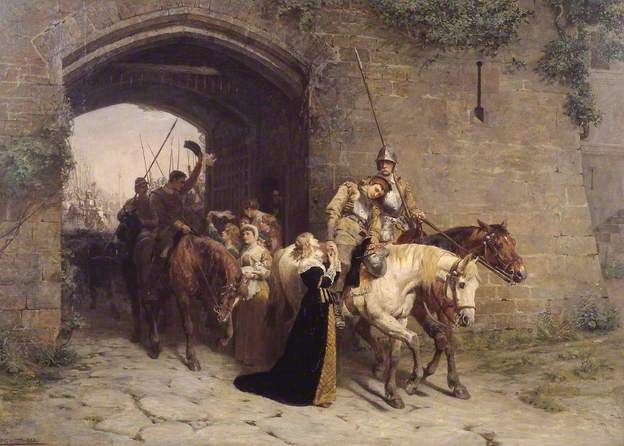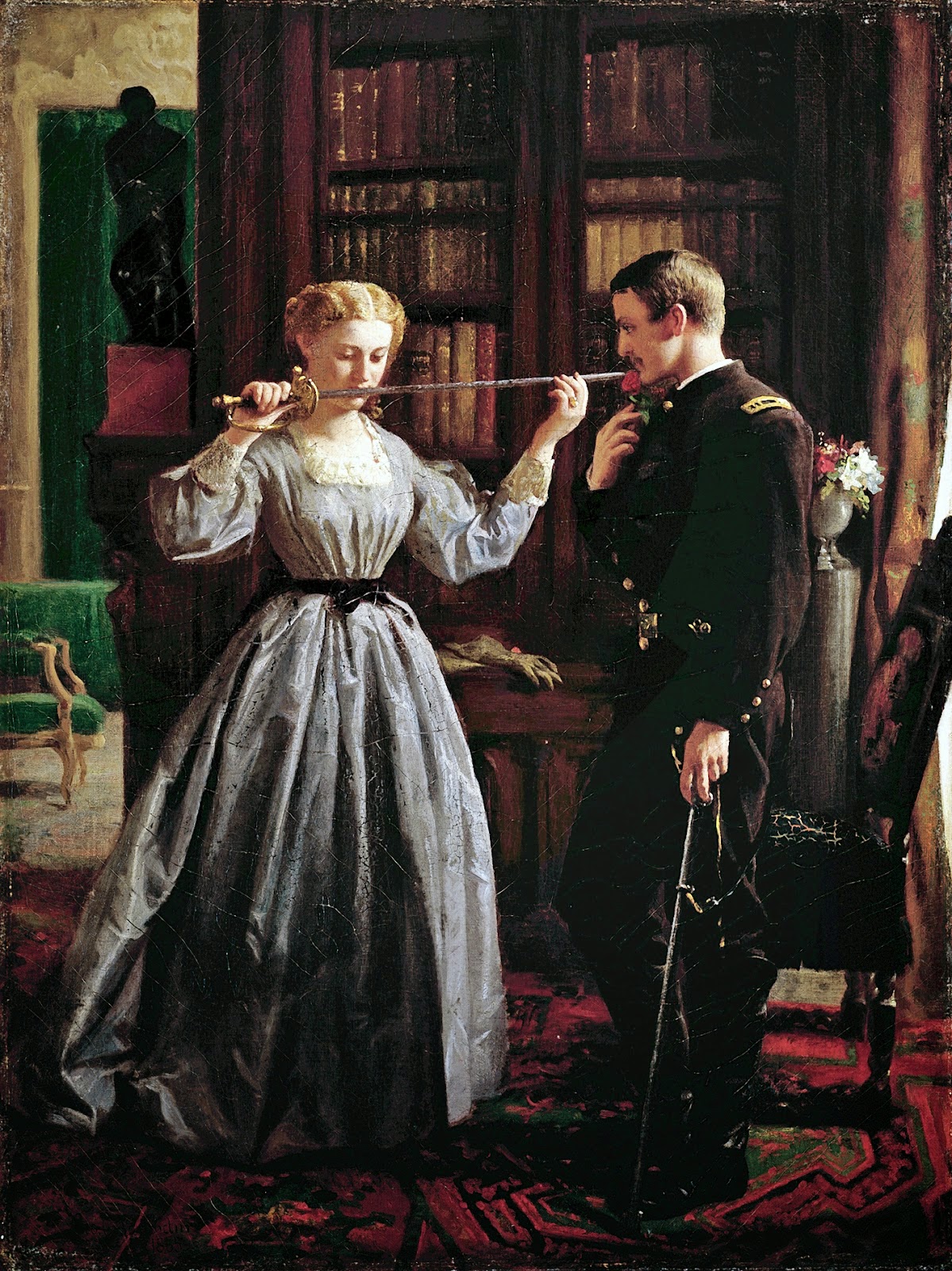 |
| The Black Brunswicker (1860) John Everett Millais |
I’m guessing the conversation went something like this:
‘So where is this battle?’ she asked.‘Oh, it’s in a lovely bit of Eastern Europe. It’s called ‘The Valley of Death’, very nice at this time of year.’‘Are many of you going?’‘Well, you know, me, Kevin, Bob from Accounts, the usual.’‘Many on the other side?’‘Oh yeah, thousands.’‘Right, me and the dog say you aren’t going. And while we’re on the subject, there is a skull on your hat, Gavin, A SKULL!’
The lot of a military wife seems a particularly bleak one in Victorian
art. There are many pictures of gallant
young men skipping off to war with a cheery wave only to be blown in half by a
canon about five minutes later. Behind
them they leave some tearful creature with hankie...
 |
| The Viking’s Farewell Herbert Gandy |
He seemed like such a steady prospect, yet off he goes in his big boat,
no doubt off to pillage a village.
Gandy’s Viking gets all the girls, possibly because of his impressive
helmet. Not sure how effective that will
be in a conflict situation unless he can take off and hover above any battles,
humming ‘The Flight of the Valkyries’.
 |
| Wives and Sweethearts (1882) Samuel Edmund Waller |
I’m trying to decide whether or not the soldiers are coming or going in
this Civil War scene. I think they are
returning from battle as there seems to be loads of them in the distance beyond
the gate, and the chap on the white horse seems wounded. Mind you there is a girl waving a white
hankie and so they might be off to their doom.
There does seem to be something important going on with our central
couple. She’s in a bold sweep of black,
contrasting with his white horse. I don’t fancy his chances, he’s far too
pretty to live.
 |
|
Summoned to Waterloo, 1815 Robert
Hillingford
|
My favourite bit of Vanity Fair is when horrible George meets his satisfyingly pointless end at Waterloo. Call me callous but he deserved it. Anyway, I’m sure all of Hillingford's jolly looking chaps are going to trot back after the battle, completely unscathed, especially the chap about to mount his horse with one woman buffing his armour and a bevy of groupies lurking nearby. The figure on the left who seems to be looking at everyone rather doubtfully strikes me as an interesting touch. He looks like he knows something the rest of us don’t. In Green's picture the women seem to be going along to the battle as well, despite the title inferring that they should be left behind. That lass in yellow is not letting go. It's a rather discomforting juxtapositioning of the merry skipping children and the drum-and-flute boys. I'm sure they'll be fine. Absolutely fine. Yikes.
 |
|
Adieu (1901) Edmund Blair Leighton
|
‘I’m off to Trafalgar…’‘Right-o. Bye.’
Unfortunately for this young naval chap, he seems to love the least
bothered looking woman ever. I’m sure
she’s just hiding her heartache really, really well and not just thinking about
what she’s going to have for tea.
‘Try not to get killed by the French.’ Have chips been invented yet? I
really fancy some chips…
 |
|
Wives and Girlfriends (1860)
John J Lee
|
These wives and girlfriends (WAGs in common parlance) look far more emotional at the departure of their menfolk. I love the contrast between the bright and varied colours of the women’s clothes and the sea-shaded blues of the men. Our central couple look very devoted and possibly the little boy in white is their son, destined to grow up and be a sailor like his Dad. The chap at the back has two women bidding him goodbye – has he brought along both his wife and his girlfriend? That seems a bit greedy as some of the chaps don’t have anyone waving them off and the chap on the left is forced to stare out at us until we all get uncomfortable. Moving on…
 |
|
The Parting (1872) James Tissot
|
This young man has obviously opted to go to war because everyone’s hats have become ridiculous. Everyone is so upset that they haven’t touched their tea, but the moment he leaves I bet the woman on the right will eat the cake in one sitting. Mind you, it’s fruit cake. For moments of emotional distressed fruit cake will be of no help whatsoever, unless it has been well and truly steeped in brandy.
 |
|
Recalled to Service Robert
Collinson
|
I think this lass is being a bit defeatist – at least wait until he’s
dead before putting on the black. I get
the impression that the woman is not going to let go of her chap as the train
pulls away. She did want something to
remember him by, so she kept his left hand.
Ah, that reminds me of a touching song, I hold your hand in mine by Tom Lehrer:
‘My joy would be complete, dear,If you were only here,But still I keep your handAs a precious souvenir.’
 |
|
The Consecration George
Cochran Lambdin
|
Turns out in the 19th century you didn’t need to be a British
painter to do romantised images of impending war death. Lambdin’s painting of an American Civil War bride
kissing her beloved’s sword before he goes off and snuffs it in another part of
the country is both disturbing and touching.
I might be a little harsh, he could be coming back I suppose, but he has
a cut flower in his hand, there is an ominous shadowy figure on the left and
the bookcase has the shape of a cross on it.
I’m horribly scarred by the many hours I have spent watching Ken Burn’s
documentary series on the American Civil War (one of Mr Walker’s favourites)
and so am under no illusions that it was at all romantic. Mind you, Shelby Foote will always remain one
of my favourite military historians, possibly because he reminds me of Donald
Sutherland. Sorry, straying from the
point. To sum up, yes, so utterly
doomed.
 |
|
Farewell (1900) Robert
Alexander Hillingford
|
There comes a point where you think these paintings should be more
honestly titled, for example Farewell
above could be called Most of Us Die by
Puzzlingly Outraged Natives, although I guess these chaps are off to the
Boer War which had begun the year before.
As we have discussed before, I think the Boer War was a dress rehersal
for the First World War in British Society.
If you ascribe to the believe that the roaring ‘20s were a reaction to
the horrors of the War then possibly some of the frivolousness of Edwardian
England was influenced by exactly how appalling the Boer War was. War stops being romantic at this point as it’s
against another nation similar to ours and there are no winners, just lots of
disease, starvation and bloodshed.
 |
|
Return to the Front (1917)
Richard Jack
|
At this point, the military wife becomes an equal opportunity position as the vast sea of men in this picture represents the fact that everyone went to war. Compared with the other scenes of frenetic tenderness or patriotism, this is a sombre, determined affair. Compared with other First World War art, it is possibly more traditional and less hard hitting, but I think the figure of the young Scottish soldier, sat at the front, oblivious to (or maybe purposely ignoring) the girl with her religious magazines is very powerful. At the back, a man lifts a gun with a hat on the top as if to say that they are all just weapons in uniforms, for all the tender emotion of their goodbyes.
As a branch of War Art, the 'wives and girlfriends' image of this sort have been somewhat archived, although occasionally you see glimpses of it. I remember the Naval Task Force returning to Portsmouth after the Falklands War and the sweethearts waiting in the dockyard to see their menfolk again after the conflict. We don't tend to concentrate on the partings so much now, maybe because we are finally cured of our enjoyment of war-related pathos. I think we're probably better off without it.

I am a lurking rabid fan of your blog.
ReplyDeleteHave you seen Bing today?
http://www.bing.com/
Wombat love!!!
Wombat love indeed! Thanks!
ReplyDeleteIt is interesting how now when artists touch on war, it's almost always to protest it, or convey its horrors. I think it may be partly because tragedy is rare in our lives compared to that of people in the Victorian era, so we are startled and outraged when someone dies young. For the Victorians, it was normal for people to die in droves at all ages.
ReplyDeleteI think artists need to be very thoughtful about how they portray war. A lot of recent art I have seen with the subject matter of war has been aimed at either shaming soldiers or making people feel that war is only ever horrible, nasty, and uncalled for. Even if all of that is true (which depends on one's views), I see the damage that it causes to soldiers; they feel alienated and despised, or like they should be ashamed of everything they accomplished. Think of the Vietnam War veterans, many of whom hid the fact that they served in that war, even though the majority were drafted and had NO CHOICE. Many of them were spit on and discriminated against. I think artists need to be compassionate and careful when they touch this subject. One can disagree with someone without vilifying them. That rarely accomplishes anything productive.
That was a rather long ramble. :D On a more cheerful (?) note, your recent posts have reminded me that I got to go see Waterhouse's "I Am Half -Sick of Shadows" painting of the Lady of Shallot in Ontario! I need to post pictures up.
Thanks for your comments, Grace.
ReplyDeleteI love your stories for the pictures!
ReplyDelete